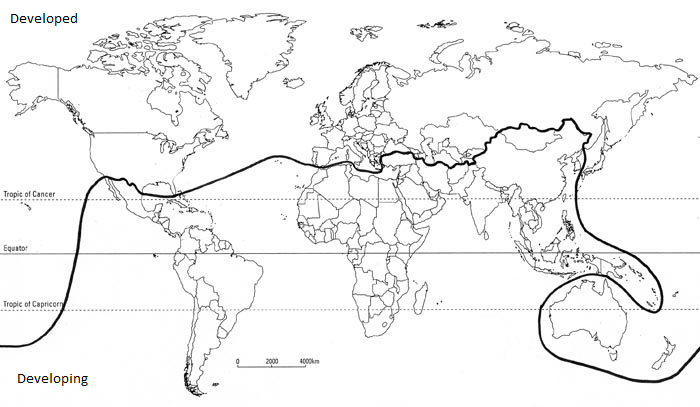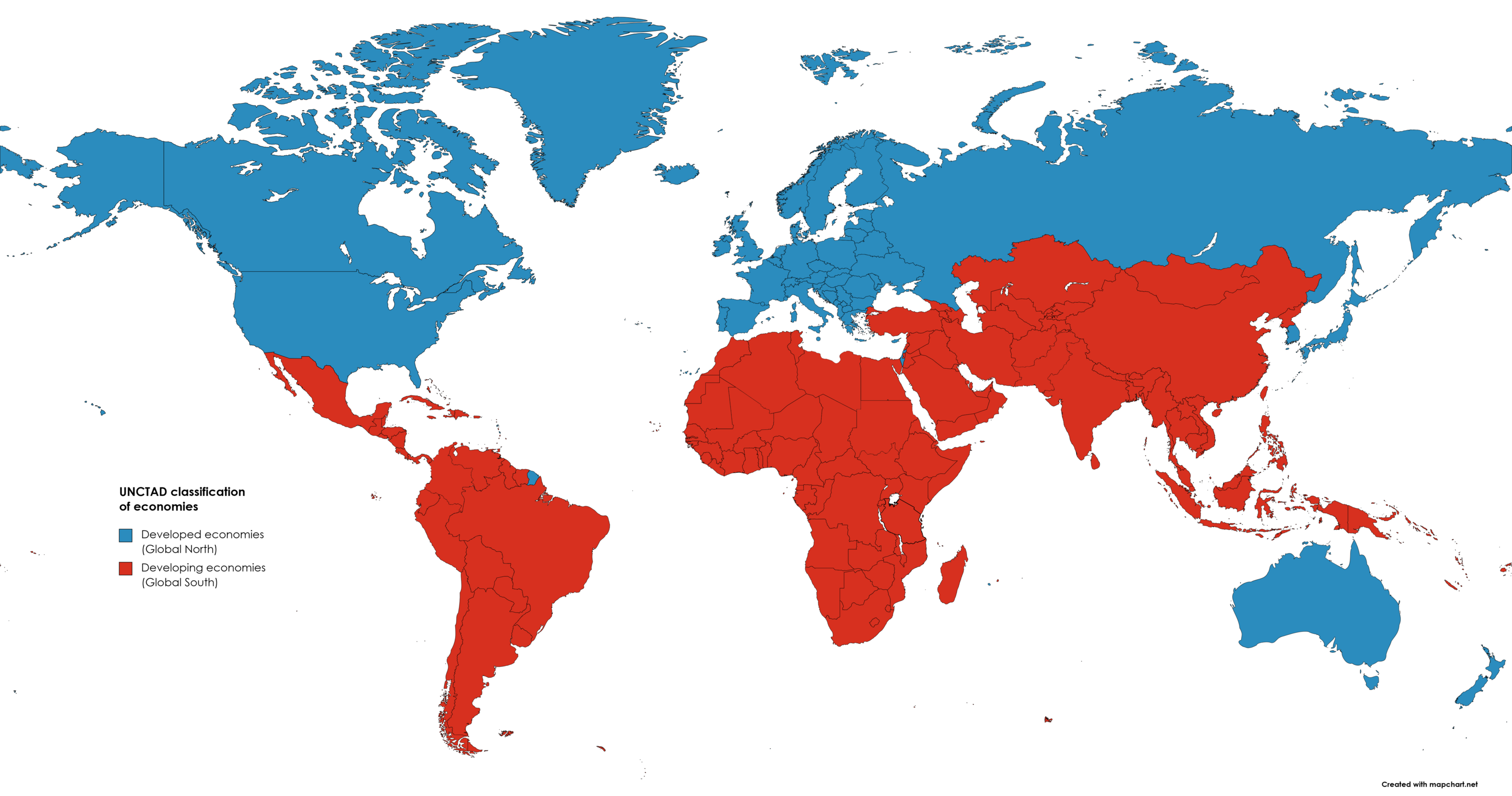The Global North and The Global South
The terms Global North and Global South emerged in the second half of the 1900s as alternatives to earlier, more rigid categories such as First World, Second World, and Third World. The Brandt Line, a concept introduced in the 1980s, provided a simple visual representation of this division, separating the world's wealthier, industrialized countries (the North) from poorer, developing ones (the South). While a simplification, this framework offered a compelling image of global inequality and became a widely used reference point in discussions about development.

The Brandt Line
The Brandt Line and UNCTAD
While the Brandt Line offered a popular visualization, international bodies like the United Nations Conference on Trade and Development (UNCTAD) were instrumental in formalizing these global classifications for policy and international cooperation. Rather than relying on a strict geographic line, UNCTAD introduced more technical distinctions, such as developed economies, developing economies, and economies in transition. Over time, these categories grew more nuanced, but the broad conceptual division between a North and a South remained central to the work of the United Nations. Although the economic realities of specific countries have changed since the 1980s, this general framework continues to shape official reports, international negotiations, and aid programs, making it an institutionalized feature of global economic dialogue.

Classification by the UNCTAD
A New Political Identity
The Global North-South framework influenced more than just international policy; it reshaped how societies perceived themselves and their place in the world. For many in the North, the division highlighted structural inequalities and prompted calls for aid, trade reform, and more inclusive global governance. For countries in the South, the term provided a shared identity that transcended national and regional differences. It fostered solidarity among nations that, despite their diverse cultures and histories, faced common challenges related to poverty, colonial legacies, and marginalization in the global system. This perspective created a new narrative of development. The South was no longer viewed primarily as a passive recipient of aid from the North but as a collective agent.
South-South Cooperation
The principles of South-South Cooperation (SSC) predate the term itself, with ideological roots in the 1955 Bandung Conference, where newly independent Asian and African nations gathered to promote solidarity and oppose colonialism. Officially framed by the United Nations in the 1970s, SSC describes collaboration among developing countries in areas like trade, technology, and infrastructure. The guiding ideal is that nations with shared experiences can exchange knowledge and resources on terms of equality and mutual benefit, challenging the traditional, top-down flow of assistance from the Global North.
In practice, however, the landscape of SSC is far more complex. The rapid growth of major emerging economies, particularly China, India, and Brazil, has introduced new power imbalances within the Global South. While this cooperation provides crucial alternatives for financing and development, it can also create new forms of dependency, debt, and strategic competition. The narrative of partnership based on shared struggles does not always align with the geopolitical and economic interests that drive these relationships. Furthermore, SSC projects can face significant challenges regarding transparency, environmental standards, and labour protections.
A New Global Dynamic
Contemporary North-South relations are defined by a central tension between enduring power structures and new assertions of influence. While countries of the Global North continue to hold dominant positions in key international financial and political institutions, this established order is increasingly challenged by the growing assertiveness of the Global South. This shift is best exemplified by the rise of influential blocs like BRICS (Brazil, Russia, India, China, and South Africa). By creating alternative economic and political forums, these nations actively contest the existing global framework and advocate for a more multipolar world. This dynamic, pitting historic inequality against a rising demand for a more balanced system, will ultimately shape the future of international cooperation and conflict.
Video
A music video on borders between the global north and south [4m 51s]
New Model Army is a British alternative rock band that has been active since the 1980s and is known for lyrics that sometimes address various social issues. The composition under examination offers a narrative of the practical challenges associated with global migration and labour systems. It outlines the realities of border crossings, documentation procedures, and institutional controls that differentiate the movement of goods and capital from that of individuals.
Lyrics
You could be there - on a dark October night
Waiting for the moment to be swimming across the freezing river
Holding a plastic bag of belongings just out of the water
Climbing up the banks on the other side, hiding in the trees
So cold that you hardly show as a target
On the heat seeking gear of the Border Control
But you made it, you're another one over
Sleeping on a bench in a railway station in the heart of Europe
Haven't eaten anything for two days straight
But where there's a will, there's always going to be a way
And every door is guarded and every guard costs money
So the women are bought and kept and raped and sold as slaves
Because the family borrowed from The Man
And The Man has always got to be repaid
For the deals of the borders and the fake IDs
And the stolen passports all locked away
While the women are working and gagging down on their knees
And somewhere in the back of Terminal Three
In the clogged-up corridors of the Immigration Authorities
Whole families with the wrong bits of paper
Are waiting to be sent back to where they came from,
Escorted by officials out across the tarmac
With their wrists bound tight with cable-ties behind their backs
It's dawn and there's fog in Rotterdam harbour
And the guard's on his break and the dogs are chained by the wire
Three figures come out from behind the cranes
And make it across the train tracks
Clamber aboard a Panamanian freighter headed for the Isle of Grain
Find a place to hide in a stack of containers - another payload of World Trade
Because goods are free to move but not people
Oil is free to move but not people
Jobs are free to move but not people
Money is free to move but not people
And today they got a man hauled off a truck in the Port of Calais
We watch them in silence as they lead him away clutching his battered suitcase
But his face betrays him - lost and scared and defeated
Sitting in the back of the white Port Authority van
Well, where do any of us come from? It's pretty hard to say
While high in the sky above us tonight
The bombers are heading the other way - south and east
Into the blood red crimson sunrise of another Imperial day
(Sullivan/Dean)
Source: https://www.newmodelarmy.org/the-music/lyrics/97-another-imperial-day
Discussion
1. The text states that the Brandt Line was a "simplification" but also a "compelling image." Discuss the primary benefits and drawbacks of using such simplified models to explain complex global realities like economic inequality.
2. How does the concept of a shared Global South identity help or hinder the unique development goals of individual nations within that group? Does a country like Brazil share enough in common with a country like Bangladesh for the label to be consistently useful?
3. The Brandt Line places Australia and New Zealand in the Global North despite their geographic location in the Southern Hemisphere. Conversely, it places some rapidly developing and wealthy nations (e.g., Singapore, Qatar, South Korea) in the Global South. What do these exceptions reveal about the limitations of a purely geographical or static economic model for understanding global divisions?
4. The lyrics contrast the free movement of goods, oil, and money with the restricted movement of people. What does this reveal, if anything, about the priorities and power dynamics of the contemporary global system?
5. The song concludes by contrasting the northward journey of a migrant with the observation that "the bombers are heading the other way: south and east." In what ways does this line connect the issue of migration to the broader dynamics of conflict and military intervention in North-South relations?
Critical Thinking
1. Examine the relationship between the analytical, institutional perspective of the article and the personal, lyrical perspective of the song. The article presents broad concepts like structural inequalities and multipolar world, while the song illustrates the human consequences of these systems for individuals. Analyze how these two narratives interact with and inform each other. How does the institutional framing provide context for the individual's experience, and how does the personal narrative add a human dimension to the abstract concepts discussed in the article?
Further Investigation
1. Investigate the rise of specific economic blocs like BRICS. Look beyond their economic influence and research their stated political goals. How do these goals challenge the existing international framework dominated by institutions traditionally led by the Global North, such as the World Bank or the International Monetary Fund?
2. Research the historical development of concepts like international aid and development assistance. Trace how the narrative around these concepts has shifted from a top-down, donor-recipient model to a more collaborative, partnership-based approach. How does the concept of South-South Cooperation fit into or diverge from this historical evolution?
Notes: Country data were sourced from the International Monetary Fund (IMF) and the CIA World Factbook; maps are from Wikimedia, licensed under Creative Commons Attribution-ShareAlike (BY-SA). Rights for embedded media belong to their respective owners. The text was adapted from lecture notes and reviewed for clarity using Claude.
Last updated: Fall 2025
